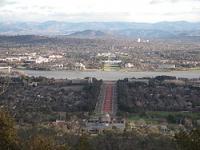|
|
|
Canberra (c-eniconˈkænbᵊrə or c-enˈkænbɛrə) is the capital city of Australia. With a population of over 345,000, it is Australia's largest inland city and the eighth-largest city overall. The city is located at the northern end of the Australian Capital Territory (ACT), 280 km (174 mi) south-west of Sydney, and 660 km (410.1 mi) north-east of Melbourne. A resident of Canberra is known as a "Canberran". The site of Canberra was selected for the location of the nation's capital in 1908 as a compromise between rivals Sydney and Melbourne, Australia's two largest cities. It is unusual among Australian cities, being an entirely planned city. Following an international contest for the city's design, a blueprint by the Chicago architects Walter Burley Griffin and Marion Mahony Griffin was selected and construction commenced in 1913. The Griffins' plan featured geometric motifs such as circles, hexagons and triangles, and was centred around axes aligned with significant topographical landmarks in the Australian Capital Territory. The city's design was heavily influenced by the garden city movement and incorporates significant areas of natural vegetation that have earned Canberra the title of the "bush capital". The growth and development of Canberra were hindered by the World Wars and the Great Depression, which exacerbated a series of planning disputes and the ineffectiveness of a sequence of bodies that were to oversee the development of the city. The national capital emerged as a thriving city after World War II, as Prime Minister Robert Menzies championed its development and the National Capital Development Commission was formed with executive powers. Although the Australian Capital Territory is now self-governing, the federal government retains some influence through the National Capital Authority. As the seat of the government of Australia, Canberra is the site of Parliament House, the High Court and numerous government departments and agencies. It is also the location of many social and cultural institutions of national significance, such as the Australian War Memorial, Australian National University, Australian Institute of Sport, National Gallery, National Museum and the National Library. The Australian Army's officer corps are trained at the Royal Military College, Duntroon and the Australian Defence Force Academy is also located in the capital. As the city has a high proportion of public servants, the federal government contributes the largest percentage of Gross State Product and is the largest single employer in Canberra. As the seat of government, the unemployment rate is lower and the average income higher than the national average, while property prices are relatively high, in part due to comparatively restricted development regulations. Tertiary education levels are higher, while the population is younger. |




 RSS
RSS